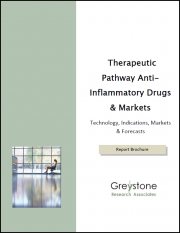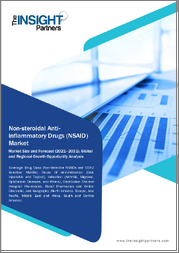
|
시장보고서
상품코드
1718480
세계의 치료 경로 항염증제 시장 : 기술, 적응증, 시장과 예측Therapeutic Pathway Anti-Inflammatory Drugs & Markets, Technology, Indications, Markets & Forecasts |
||||||
이 조사 보고서는 약물전달 분야의 성장 분야의 원동력이 되고 있는 기술, 제품, 시장 진출기업을 종합적으로 평가 및 분석한 시장 조사 보고서입니다. 전략 담당자는 흡입 중추 신경계 치료가 제약 전략과 건강 치료 프로토콜에 미치는 영향의 확대에 대해 자세히 이해하기 위해 만들어졌습니다.
원동력이 되는 복합 요인
중추 신경계에 약물을 투여하는 데는 독특한 과제가 있습니다. 물건과 생물제제를 혈액뇌 장벽을 넘어 중추신경계에 전달하기 위한 매력적인 경로가 됩니다. 이러한 잠재적인 장점은 다양한 질병에 대한 흡입 중추 신경계 치료제의 개발에 박차를 가하고 있습니다. 당사의 분석에서는 흡입에 의한 중추 신경계에의 투여는 이러한 동향을 이용해, 미래에 중추 신경계 치료제의 의약품 개발과 상업화에 있어서 중요한 요소로 발전하기에 충분한 위치에 있는 것이 나타났습니다.
자가면역에서의 치료 표적으로서의 IL-23/IL-17축 IL-23/IL-17축이 인간의 자가면역질환에 중요하다는 것이 밝혀져, 신규 치료제의 승인과 급속한 개발로 이어지고 있습니다. RORyt과 JAK에 대한 저분자 억제제가 치료법의 전망을 바꾸고 있으며, 현재 3 다스의 다른 제품이 승인 또는 임상 개발 중입니다.
무엇을 배울까
- 어떤 흡입성 약제가 분말로 공급되고, 어떻게 판매되고, 어떠한 디바이스가 있어, 누가 판매하고 있는가?
- 어떠한 흡입 건조 분말약이 후기 개발 단계에 있어, 개발자는 누구로, 어떠한 적응증을 대상으로 하고 있는가?
- 흡입 건조 분말 약/디바이스 수요를 촉진하는 주된 요인은 무엇인가?
- 현재 시장 규모, 시장 점유율 리더는 누군가, 2024년 시장 점유율은 어떻게 될까?
- 의약품 개발 기업과 디바이스 제조업체의 관계는 어느 정도 중요한가, 또 업계에 있어서의 주요한 제휴 관계는?
- 건조 분말 흡입 제품에 필수적인 설계 요인, 기술, 시장 개척의 과제는?
- 건조 분말 흡입기 시장에 영향을 미치는 중요한 경제, 기술, 규제 요인은 무엇인가?
조사 방법 :
조사 방법은 주요 시장 진출기업, 기술 개발자, 유통업체, 업계 전문가, 시장 영향자(규제 당국자, 업계 단체, 재료 규격 단체를 포함한 목록)에 대한 상세한 인터뷰 형태로 1차 조사를 기반으로 합니다.
1차 정보는 업계지 기사, 기술문헌, 업계출판물, 기업 데이터시트 및 공표정보, 정부기관 및 업계단체 통계 데이터 등의 2차 정보와 비교하여 평가하고 정규화합니다.
시장 수요 및 미래 시장 활동의 예측 및 예상은 표준 모델링 및 통계 기술을 사용하여 도출됩니다.
목차
- 주요 요약
- Th17 경로
- Th17 염증 경로 캐스케이드 표적
- 인터루킨 6(IL-6)
- 승인 의약품
- 개발 단계의 의약품
- 인터루킨 IL-6R
- 승인 의약품
- 개발 단계의 의약품
- 야누스 키나아제/티로신 키나아제 억제제
- 승인 의약품
- 개발 단계의 의약품
- 신호전달단백질
- 신호전달 및 전사 활성화 인자(STAT)
- 인터루킨-21(IL-21)
- 인터루킨-21R(IL-21R)
- 인터루킨-23(IL-23)
- 승인 의약품
- 개발 단계의 의약품
- 인터루킨-23R(IL-23R)
- 인터루킨-17A(IL-17A)
- 승인 의약품
- 인터루킨-17C(IL-17C)
- 개발 단계의 의약품
- 인터루킨 17A/17F
- 개발 단계의 의약품
- 인터루킨-17RA(IL-17RA)
- 승인 의약품
- 트랜스포밍 성장 인자-베타 RI/RII(TGF-베타 RI/RII)
- 개발 단계의 의약품
- 레티노산 관련 오판 수용체 RORyt
- 개발 단계의 의약품
- 인터루킨 17
- 개발 단계의 의약품
- 인터루킨-22(IL-22)
- 시장 상황
- 시장 규모
- 경쟁 구도
- Th17 경로를 통한 염증성 질환
- 획득 가능한 최대 시장 규모
- 경쟁 구도
- 시장 진출기업 프로파일
This new market study, "Therapeutic Pathway Anti-Inflammatory Drugs & Markets" is a comprehensive evaluation and analysis of the technology, products and participants providing the driving force behind this growing segment of the drug delivery sector. The report has been designed and developed to provide pharmaceutical company decision makers, drug developers and formulators, drug device designers, and industry strategists with a detailed understanding of the expanding impact of inhaled CNS therapies on pharmaceutical strategies and healthcare treatment protocols. Provider organization business managers, healthcare administrators and investors will also benefit from this publication.
Converging Factors Driving
Delivering drugs to the central nervous system presents unique challenges. But, drug developers and researchers have discovered that delivering CNS therapeutic drugs via inhalation mitigates several of these issues. The accessibility and vascular structure of the nose make it an attractive route for delivering both small molecule drugs and biologics across the blood-brain barrier to the CNS. Pulmonary delivery to the deep lung can have favorable pharmacokinetics. And inhaled delivery offers the potential for faster onset of action and less frequent dosing relative to oral drugs. These potential advantages have spurred activity in inhaled CNS therapeutics for a range of disorders. As aging population demographics and managed care initiatives drive growth in home health care and self-administration of drug therapies, inhaled medicine is increasingly being viewed as patient-friendly and cost-effective. Our analysis indicated that inhaled CNS administration is well positioned to take advantage of these trends and evolve into a significant factor in the future of pharmaceutical development and commercialization of CNS therapeutic drugs.
The IL-23/IL-17 axis as a therapeutic target in autoimmunity The identification of the IL-23/IL-17 axis as critical for human autoimmune disease has led to the approval and rapid development of novel therapeutic agents. Monoclonal antibodies to a variety of cytokines and cytokine receptors and small-molecule inhibitors of RORyt and JAKs are changing the therapeutic landscape, with three dozen distinct products now approved or in clinical development. Humanized monoclonal antibodies to both IL-17 and IL-17RA are enabling improved outcomes for moderate to severe psoriasis as well as psoriatic arthritis.
What You Will Learn:
- What inhalable drugs are supplied in powder form, how are they marketed, what are the device specifics, and who markets them?
- What inhalable dry powder drugs are in late stage development, who are the developers, and what indications are they targeting?
- What are the major factors driving inhaled dry powder drug/device demand?
- What is the size of the market today, who are the market share leaders, and what will the market share be in 2024?
- How important are drug developer-device manufacturer relationships and what are the key alliances in the industry?
- What are the essential design factors, technologies and market development issues for dry powder inhalation products?
- What are the significant economic, technology, and regulatory factors affecting the market for dry powder inhalers?
Methodology:
Research methodology is based on primary research in the form of in-depth interviews with key market participants, technology developers, distributors, industry experts, and market influencers, a list that includes regulatory officials, industry trade groups, and materials standards organizations.
Primary data is evaluated and normalized against secondary sources including trade journal articles, technical literature, industry publications, company data sheets and published information, and statistical data from government agencies and trade associations.
Forecasts and projections of market demand and future market activity are derived using standard modeling and statistical techniques.
Table of Contents
- Executive Summary
- The Th17 Pathway
- Th17 Inflammatory Pathway Cascade Targets
- Interleukin 6 (IL-6)
- Approved Drugs
- Development-stage Drugs
- Interleukin IL-6R
- Approved Drugs
- Development-stage Drugs
- Janus Kinase/Tyrosine Kinase Inhibitors
- Approved Drugs
- Development-stage Drugs
- Signaling Proteins
- Signal Transducer and Activator of Transcription (STAT)
- Interleukin-21 (IL-21)
- Interleukin-21R (IL-21R)
- Interleukin-23 (IL-23)
- Approved Drugs
- Development-stage Drugs
- Interleukin-23R (IL-23R)
- Interleukin-17A (IL-17A)
- Approved Drugs
- Interleukin-17C (IL-17C)
- Development-stage Drugs
- Interleukin 17A/17F
- Development-stage Drugs
- Interleukin-17RA (IL-17RA)
- Approved Drugs
- Transforming Growth Factor-Beta RI/RII (TGF-Beta RI/RII)
- Development-stage Drugs
- Retinoic acid-related orphan receptor RORyt
- Development-stage Drugs
- Interleukin 17
- Development-stage Drugs
- Interleukin-22 (IL-22)
- Market Status
- Market Size
- Competitive Landscape
- Th17 Pathway Mediated Inflammatory Diseases
- Addressable Market
- Competitive Landscape
- Profiles of Market Participants



















